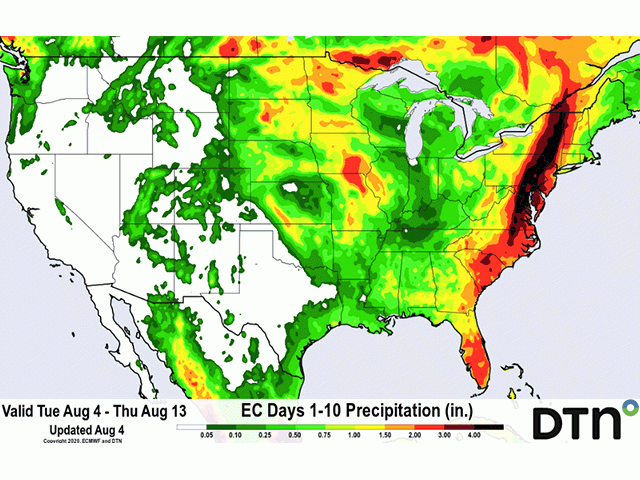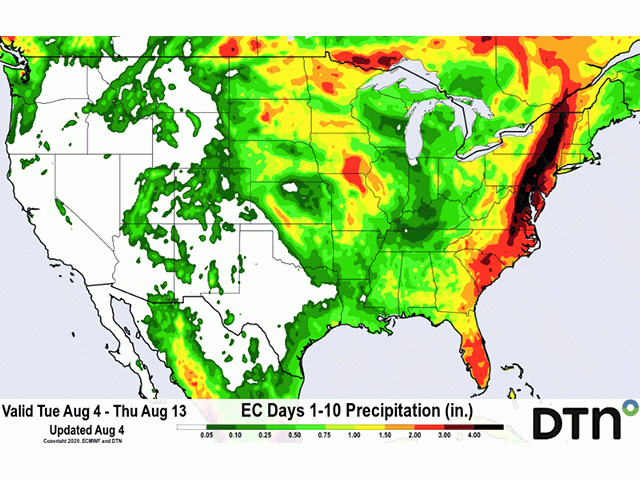Ag Weather Forum
Very Few Problem Areas
July was a pretty good month for crops overall. Good-to-excellent ratings stayed stable for spring wheat but rose through the month for corn, soybeans and cotton. The last week of the month brought good conditions to most areas as a pattern change forced cooler air southward and a strong storm complex brought moderate to heavy rainfall from the Northern Plains to the Ozarks and through the Ohio Valley.
The eastern Midwest has benefited the most. Corn and soybean good-to-excellent ratings have risen over the last two weeks for Illinois, Indiana, Ohio and Michigan. The combined good-to-excellent rating totals have shown 8- to 13-percentage-point increases in the eastern Midwest, a testimony to the development of more substantial rainfall as well as temperatures backing away from very warm to hot levels.
Not all areas have been as fortunate, particularly in Iowa. Some showers did develop on July 29 but were isolated in a thin band over the drier sections of the state. Thus, crop conditions fell again for the second consecutive week. Crop ratings are still relatively high, with both corn and soybeans showing 73% good to excellent; however, crops have been dependent on subsoil moisture, which is dwindling. The percentage of short-to-very-short subsoil moisture increased from 26% to 41% over the last two weeks. Shower activity will be paramount, but it may be too late for some of the crop, and damage has likely occurred.
P[L1] D[0x0] M[300x250] OOP[F] ADUNIT[] T[]
Another dry spot is the middle of the Delta region in northeast Arkansas and western Tennessee. Rainfall has largely missed this section of the region over the last 30 days with precipitation around 40%-60% of normal. Reproductive to filling cotton and soybeans could use more substantial precipitation in this section.
Lower temperatures across the major growing areas have reduced the amount of evapotranspiration and water demand for filling corn and soybeans over the last several days. But the forecast is for an expanding ridge across the majority of the country and rising temperatures through the weekend and above-normal temperatures through next week. This will continue to stress these drier sections if they do not receive more precipitation.
The forecast is for more transient systems over the next 10 days. This leads to more localized precipitation, though it may be heavy where it occurs. These storm complexes are expected mostly across the Northern and Central Plains into the western Midwest. Drought areas of Iowa are in the coverage area for these systems; however, if they miss, the dryness and stress will intensify. The Delta will mostly be missed and reliant on isolated showers over the next 10 days, which does not bode well for the region's drier midsection.
The precipitation will not be as welcome for spring wheat in the Northern Plains. Harvest is underway and currently stands at 5% complete. The later planting in portions of North Dakota and Minnesota could still make use of rainfall, but most areas are looking forward to drier conditions for drydown and harvest. Thunderstorms are more likely across the region through Aug. 9. A few days of dryness may occur afterward before showers and thunderstorms become more likely again toward the end of next week.
John Baranick
DTN Ag Meteorologist
© (c) Copyright 2020 DTN, LLC. All rights reserved.






Comments
To comment, please Log In or Join our Community .